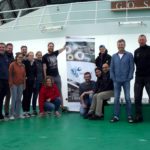The 2017 SponGES cruise onboard the research vessel G.O. Sars just successfully concluded. For three weeks, an international and well mixed team of SponGES researchers has worked 24/7 to study very different deep-water sponge grounds, ranging from the 1300 m deep Norwegian fjords, the coral-associated grounds on the outer continental shelf, the Barents Sea, and to depths down to 3000 m along the Arctic Mid-Ocean Ridge.
Landers equipped with a set of sensors and devices have been deployed on the bottom at different depths and for different periods (including almost one year, from the last G.O. Sars cruise). Short- and long-term monitoring of environmental conditions is crucial to understand the preferred environmental setting needed to sustain sponge grounds, helping to explain why they are growing exactly where they are, and enabling predictions about the effect a changing environment will have on their distribution in the future. To such an end, SponGES researchers collected data from the water column around and above the sponge grounds, took sediment samples and measured the near-bed environmental conditions. Further work and data analysis will be carried out on stored samples once back to the labs.
In-situ incubation experiments have been carried out deploying incubation chambers between 1000 and 800 m depth, and deep-sea sponge specimens have been collected to be transported live back to Bergen or for mesocosm experiments to be run onboard. The latter complement the work performed with incubation chambers on the seafloor, exploring the uptake of different natural food sources (bacteria, phytoplankton, viruses, and dissolved organic carbon (DOC)) by the sponges. Results from these experiments will help us to understand their role in oceanic nutrient cycling.
A combination of video footage and ROV-mounted multibeam has proved to be a very powerful tool for fine-scale mapping of the seabed, leading to maps with only 1 cm resolution where even single sponges are clearly visible. Coupled with new information on reproduction, genetic diversity and physiological responses of deep-sea sponges, these maps will help assess the direct and indirect impact of stressors such as bottom trawling on sponge grounds, and also to forecast their recovery potential thereby improving fishery management.
The first days of the cruise were covered by a troupe from Euronews, to be featured in the award-winning program “Futuris” from August 28th, broadcasted to over 150 countries and in 12 languages (it will be eventually stored on the Euronews YouTube channel). Facebook live from the ROV dives and short clips from the Euronews troupe can also be enjoyed on our social media pages (enjoy a rich photogallery here!).
Running an expedition like this requires substantial technical and financial support. In addition to the funding from the European Commission we have relied heavily on ship-time granted by the University of Bergen, the technical infrastructure built up around the Ocean Laboratories and K.G. Jebsen Centre for Deep-Sea Research in Bergen and NIOZ in the Netherlands, as well as project funding by the Norwegian Biodiversity Information Centre (Artsdatabanken). Further to this, a huge thanks goes to a great team of pilots and engineers of the ROV Ægir, a very helpful and skilled crew!
